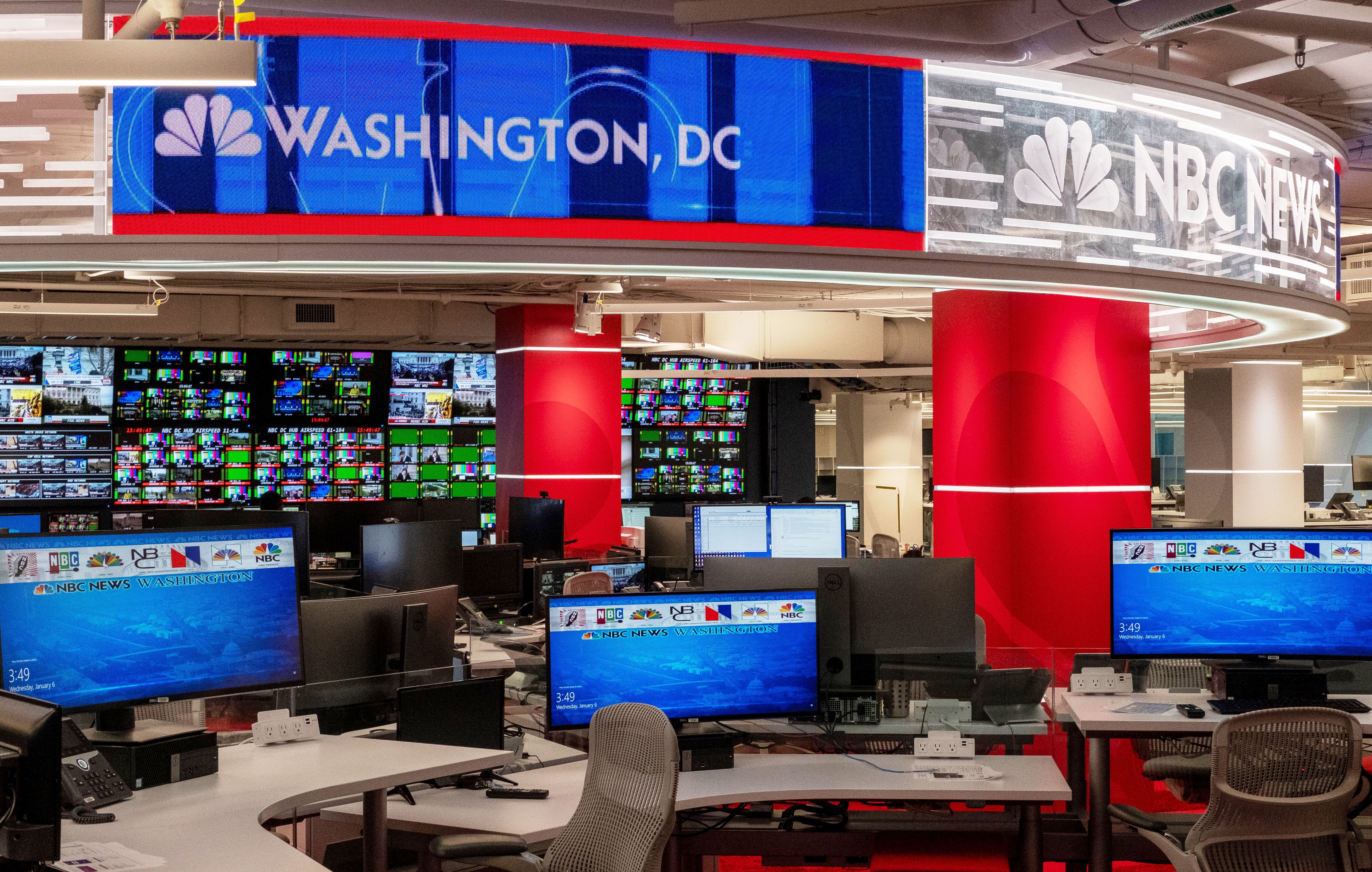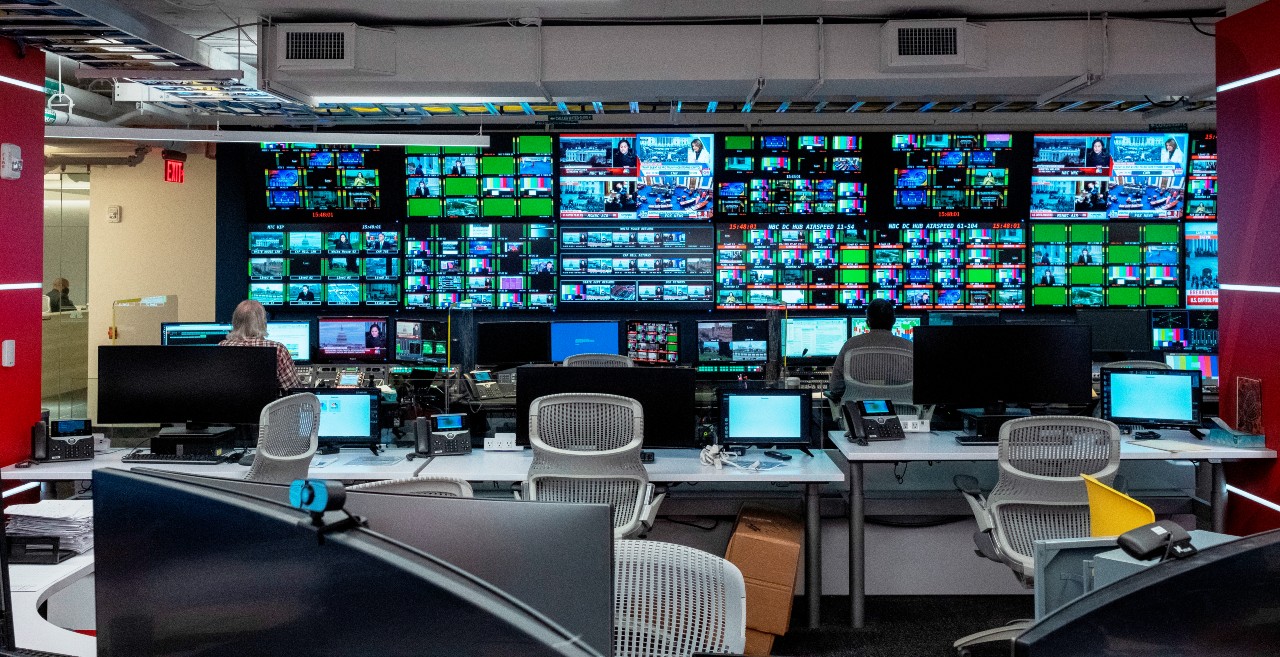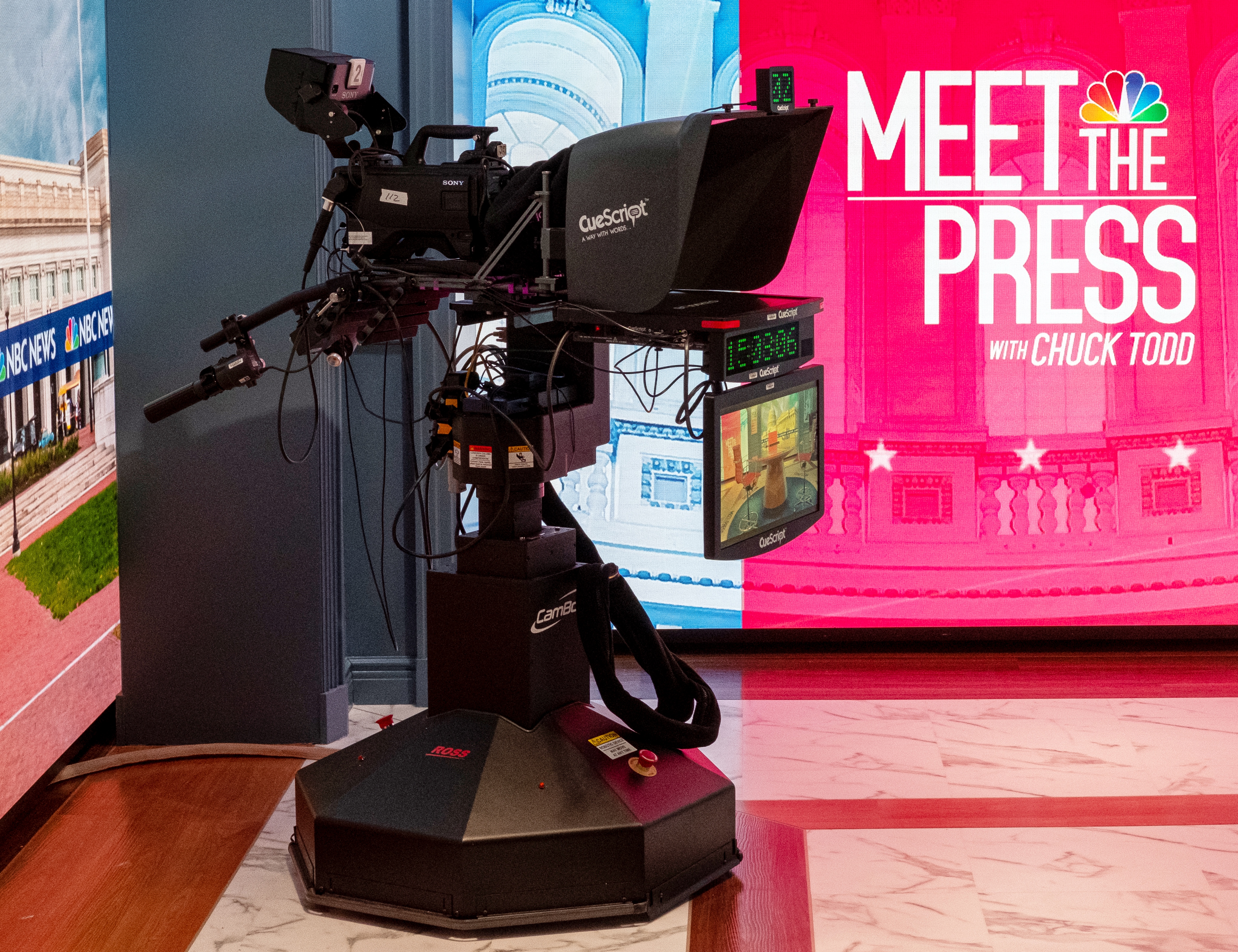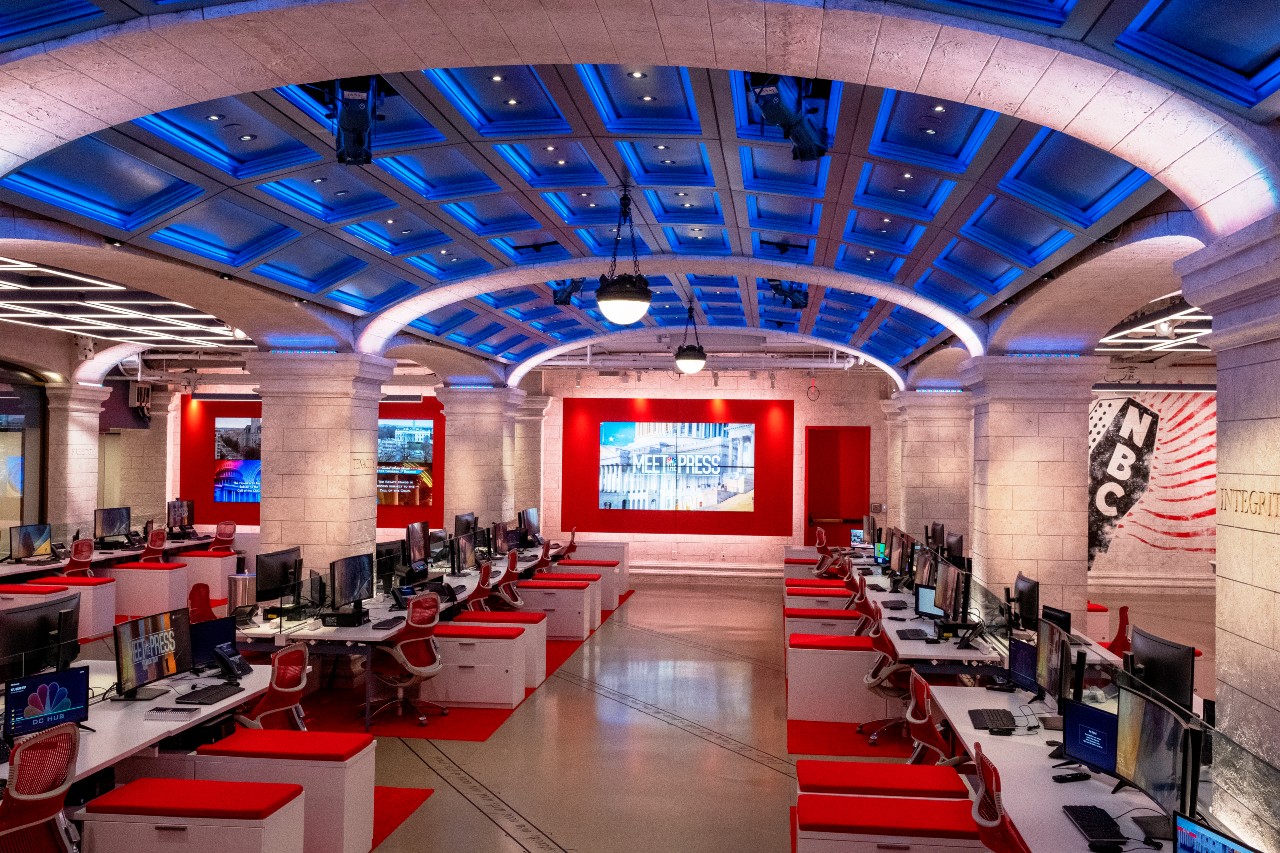A Look at the Tech Behind NBC’s New Washington News Bureau
The new six-floor 80,000-square foot facility replaces the former studio and technical operations

WASHINGTON, D.C.—After operating for more than six decades from facilities shared with its O&O station, WRC-TV, in the northwest corner of the nation’s capital, NBC is now hosting its news and other network operations from a new facility located just steps away from Capitol Hill.
The official ribbon cutting was held earlier this year culminating a project that had its genesis in mid-2016.
“NBCU News Group’s Washington Bureau took four years from initial planning to completion,” said Jay Hurt, vice president of engineering at NBC News. “We started our design conversations with architectural firms in the late summer of 2016 and began building in summer 2019.”
The new six-floor 80,000-square foot facility replaces the former studio and technical operations conducted at 4001 Nebraska Ave., and features seven studios, the largest of which has a floor space of some 2,400 square feet. Two others are approximately 40 x 40 square feet, and a fourth provides some 900 square feet of production space.
“The remaining three studios are smaller for single camera shots [and measure] about 24 x 10, each with a live window view of the U.S. Capitol for guests and correspondents,” said Hurt, noting that the design of the new facility also incorporates 10-foot-high floor-to-ceiling windows similar to those installed in a ground-floor studio at the network’s 30 Rock New York City headquarters to allow the public to view ongoing studio operations. In addition, the facility includes large exterior-facing LED video displays for those outside the building to view program streams and news tickers. It features one large master control area and three smaller sub-control rooms.
Planning included sufficient workspace for more than 400 NBCU staffers, as the new facility is home not only to NBC News, but also houses the Washington, D.C. operations of MSNBC, CNBC, Telemundo, the NBC News Channel, NBC News Digital, and SKY News.
In addition to daily news broadcasts, programming originating from the new Capitol Hill facility includes Meet the Press with Chuck Todd, Weekend TODAY, as well as MSNBC shows such as The ReidOut with Joy Reid, MTP Daily, Andrea Mitchell Reports, MSNBC Live with Hallie Jackson, Way, The Cross Connection with Tiffany Cross and The Sunday Show with Jonathan Capehart. It will also originate special programming for the network’s TODAY show, NBC Nightly News with Lester Holt, and NBC News Special Reports.
Get the TV Tech Newsletter
The professional video industry's #1 source for news, trends and product and tech information. Sign up below.
Hurt said that the design of the new facility was a collaborative effort between the NBCU News Group’s internal team and Austin, Texas-based system integrator, Beck Systems. DPR Construction was in charge of the actual buildout.

FLEXIBILITY-DRIVEN DESIGN
With the move away from wired microphones, IFBs and intercoms during the past few years, the NBCU facility was designed with as much flexibility as possible in this area.
“We installed a Jetwave Wireless IFB, PL and mic system throughout the multi-floor facility allowing any crew member, guest, or talent to be connected to any show, control room or studio and freely move around between floors,” said Hurt. “The system is also married to our digital audio network (Calrec and Dante) to provide even more flexibility.”
The facility can accommodate some 36 wireless microphones and 24 wireless IFBs, with antennas installed throughout the building to facilitate the movement of talent and crews during shows.
Hurt said that Sony 3100 cameras were purchased for use in the main lobby-level studio, and existing Sony and Panasonic cameras were deployed to the other studios. All are remotely operated.

“We are utilizing Ross robotic peds in all the multi-camera studios and Telemetrics for our single flash-cam locations and beauty cam shots around town,” he said. “We also networked all this hardware, allowing for control from our 30 Rock headquarters in New York. A robo-operator in New York can control the cameras here in D.C. and we can jump in and back up our 30 Rock operations from D.C.”
Other suppliers of equipment for the facility include Evertz for the technical infrastructure, RTS for intercom systems, and Planar and Neoti for the 650 square-feet of tracking LED studio monitor walls
Hurt observed that while the design is not fully IP-based, this technology does play a large role in overall connectivity.
“The core router is all IP but we do utilize several optical-to-electrical gateways to move everything in and out of the plant,” said Hurt. “We used a mix of IP and traditional HD electrical equipment. The internal connectivity is a mix of fiber, CAT-6 and some traditional broadcast copper. The ratio between the two is about 80 percent fiber and 20 percent copper.”
According to Hurt, some 7,000 fiber strands were installed during construction of the facility.
As editing plays a large role in news broadcasts, the new NBCU facility was designed accordingly. “We have 16 edit suites that are Avid media composers that sit on Forecast ‘sit-stand’ consoles,” said Hurt, noting that due to the pandemic, a lot of editing work has been performed by employees working from home.

High-speed connectivity with NBC’s 30 Rock facility is accomplished via 100GigE fiber, and the design also includes plenty of capacity for bringing in breaking news events with
28 LiveU ingest channels, along with connectivity from satellite receive/transmit facilities at both the D.C. WRC-TV Nebraska Ave. facility and a large dish farm in Charlotte, N.C. A total of 40 proc amp/frame syncs were installed to accommodate remote feeds.
Continuity of operations is assured by both a large UPS system and on-site backup generator capability.
NOT YOUR TYPICAL TEXTBOOK PROJECT
In addition to creating restrictions on entry to the facility by operating personnel, the arrival of the Coronavirus-driven pandemic during the construction of the news facility also complicated scheduling of crews. However, this difficulty was minor compared with a fire that broke out on one of the building’s upper floors during the renovation and buildout process.
While such an event within a broadcast operation is usually catastrophic, in this case, no one was harmed, and any delays due to the fire did not negatively impact work in progress at the new facility.
“A fire during construction made us rethink the buildout since we were essentially off the air from our existing studios on Capitol Hill,” said Hurt. “It allowed us to work without having to be concerned with on-air schedules or taking anything off the air as we built and tested the technical infrastructure.”
The pandemic also brought about a positive of sorts, as its timing led to a greater amount of flexibility that was incorporated into the facility design. Hurt noted that graphic artists are able to work remotely and display their renderings directly to the D.C. LED screens. Also, as mentioned, most editing is still being done remotely with more than 400 Avid system remote logins occurring daily.
A big obstacle that had to be cleared in repurposing of the building that formerly housed a restaurant and offices was the removal of some first-floor support columns that would have otherwise blocked camera shots in the main studio.
“We had to bring in several consultants to make that decision,” said Hurt.
And as can be attested to by anyone who has ever been involved in construction of a facility of almost any sort in our Nation’s Capital, unforeseen delays can often occur due to the number of federal and city bureaucracies that are involved. In this case it was a seemingly minor architectural detail outside the building itself—the security bollards or short vertical posts used to create an unobtrusive physical barrier between a building and nearby vehicular traffic. Hurt observed that getting approval for the bollards took nearly four years.
The original NBC Washington news facility and WRC television plant was dedicated on May 22, 1958 by then-President Dwight D. Eisenhower and David Sarnoff, president of RCA and NBC chairman of the board.
